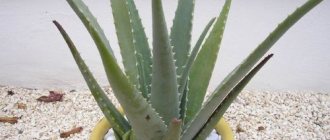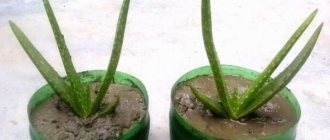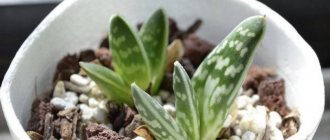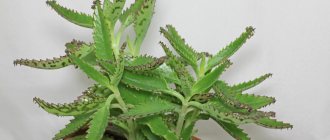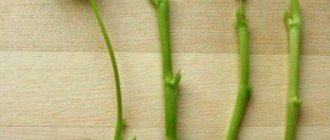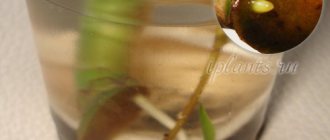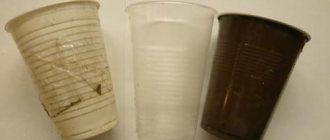Aloe is a plant that, from generation to generation, is revered in many families as a family doctor. It has been known since ancient times, described in the works of many founders of medicine - Hippocrates, Paracelsus, Avicenna. The true goddess of beauty, Queen Cleopatra, also mentioned him. Its juice helps with many diseases: it protects against runny nose, helps cope with stomach diseases and skin problems. Women of all ages make masks from it for the face, neck, and hair. Many people want to get such a flower; they ask neighbors, friends, and relatives for it. Therefore, the question of how to propagate aloe at home does not lose its relevance.
Advantages and disadvantages of the method
Is it possible to plant an aloe plant without roots? It is quite possible to grow agave in this way, although this method is not widespread among gardeners.
The method has its positive sides:
- the plant will have all the varietal characteristics of its “parent”;
- the rooted leaf grows quickly and forms babies that can be used for propagation (read more about propagation by babies here);
- planting can be carried out at any time of the year.
On a note. But this method is very expensive in terms of time and effort. In addition, in only 30-40% of cases, aloe without roots takes root.
How to plant aloe correctly at home
Before planting a succulent, it is recommended to study all the features and prepare the necessary materials and tools. When choosing aloe, planting and caring for it at home will not require much effort or expense.
Planting aloe has its own nuances
What time of year is better and is it possible in winter?
Planting and replanting a flower can be done at any time of the year. However, it is better to give preference to spring. At this time, the flower is better accepted and grows faster.
For your information! In winter, aloe has a dormant period, so it will take longer to take root and develop more slowly. But if you urgently need to save the plant from death, then you can try planting in the cold season.
What kind of soil is needed for aloe
Aloe is considered to be native to South Africa and the Arabian Peninsula. The lands there are poor, with few nutrients. Mostly the soil is sandy or even rocky. However, aloe grows and develops well in such conditions.
For home flowers, you can make the soil yourself. The simplest composition is considered to be the following:
- Take and mix 1 part of humus and 2 parts of coarse and fine sand.
- Add 1 part each of vermiculite and perlite.
Although ready-made soil for aloe is not very nutritious, the culture likes it.
Of course, home flowers are already accustomed to different soil, so the recipe for creating suitable soil for aloe is slightly different:
- Combine turf soil with greenhouse soil and humus in a ratio of 6:1:2.
- Add 2 parts of peat and sand.
Such soil contains many useful substances that are necessary for the normal development of the plant.
Note! For planting, there is also a special soil for succulents, which can be purchased at the store.
In what container is aloe grown: pot sizes
Aloe has a small root system, and the leaves are large, powerful and fleshy. Therefore, narrow and tall containers are not at all suitable for the flower; aloe simply will not develop. In addition, such a pot will constantly fall.
For culture, it is better to choose a shallow and wide container, preferably made of clay or ceramics. In plastic containers, moisture evaporates longer. As a result, root rot or the appearance of fungal diseases cannot be ruled out.
It is better to plant a small plant in a wide pot
Are there any chances of success?
While propagating and growing aloe from a rootless leaf is not an impossible task, the chances of it growing roots are very slim. The fact is that the leaves are saturated with moisture and tend to rot before their roots begin to form. You will find more nuances on how to grow aloe from a leaf in this article.
Beneficial properties of aloe
Aloe juice is used in the pharmaceutical and cosmetic industries. At home, aloe juice is used to treat inflammatory skin diseases: calluses, burns and wounds, and is also used for a runny nose. Medicinal aloe is called because of the following properties.
- Laxative and choleretic. Aloe improves peristalsis and pancreatic function, increases appetite.
- Bactericidal and anti-inflammatory. A compress of pulp is used to treat small purulent wounds.
It is important to remember that self-medication and using aloe without consulting a doctor is dangerous; this can lead to more serious health problems.
How to grow at home?
Now we’ll tell you step by step how to plant aloe without roots. The main methods here are as follows.
Place the leaf in water, then in soil
This method of growing aloe without roots is the most common. Let's look at how to grow a shoot from a leaf for subsequent planting. The following steps must be observed:
- Prepare a glass container for the leaf, pour settled water at room temperature into it and install the planting material.
- As soon as the roots appear, remove the leaf from the water and place it on a clean cloth.
- Leave the planting material in a warm place so that the film has time to form. This may take 2-3 days. The resulting film will protect the plant from soil infection.
- After this, you can transplant the plant into a prepared container with a drainage hole and 2/3 filled with substrate.
The planted shoot does not need to be heavily compacted with soil, and after planting it should be watered with settled water. Place in a dark place for 2-3 days.
What to do if a flower does not produce roots in water?
On the question of how to dissolve the roots of the agave in this case, the opinions of flower growers differ. Some say that cut leaves, if planted in water before planting in the ground, will certainly produce roots. Other flower growers are convinced that leaves rot when left in water for a long time, so it is better to plant them in the ground immediately. So the choice remains with the florist. In any case, if the method turns out to be ineffective, then the rapid reproduction of aloe will allow this procedure to be repeated without damage to the population.
Straight into the ground
This method is standard, and to implement it you must adhere to the following recommendations on how to grow roots:
- Cover the surface of the soil for planting with sand. It is better to use coarse grain, and its thickness should be approximately 2 cm.
- The fleshy leaf, dried for 2-3 days, is immersed in the ground with its lower part. The immersion height will be 2-3 cm.
- Using small leaves, cover the surface of the earth, pressing slightly.
- At first, watering should be replaced with banal spraying.
- After 8 weeks, when the first roots form, irrigation should be eliminated.
- As soon as the root system is developed, transplant the plant into soil intended for succulents.
- The surface of the ground can be sprinkled with a mixture of sand and expanded clay chips.
Methods of vegetative propagation of aloe
All types of aloe are propagated by layering, apical and stem cuttings. Cut aloe leaves do not take root. It is advisable to cut cuttings and separate layering in the spring from March to the end of April, when they take root most quickly. But if you wish, you can cut and root an aloe cutting at any time of the year.
During the growth process, a well-developed aloe produces layering . These are shoots growing from the stem. They, unlike the shoots and branches of shrubs and subshrubs, produce aerial roots in their lower part near the stem of the mother plant. On young cuttings you can see rudimentary roots.
Bush aloe species, which have a very short stem, also produce cuttings that sprout from the soil near the plant.
For bush varieties of aloe, layering is the only method of vegetative propagation . If the layer has roots, it can be immediately planted in the ground. Cuttings without roots must first be rooted.
Plants with a long, well-developed stem can be propagated by apical and stem cuttings.
The apical cutting is a fragment of a stem with a growing point and several leaves. It shouldn't be short. Its length for successful rooting must be at least 15 cm.
You can also root stem cuttings. These are pieces of the bare stem of a plant that has already lost its decorative effect. The stem is cut into pieces 15 cm long. All cuttings must be dried for 2-3 days before rooting.
Can it be placed in open ground?
You can transplant an aloe leaf into open ground, but only for the summer. If the spring in the region is warm and there are no frosts, then planting work should be carried out at the end of May.
It is important that the daytime temperature is 25-30 degrees, and the night temperature does not fall below 12 degrees.
Transplanting aloe into open ground is carried out as follows:
The first step is to choose a landing site. It should be carefully lit, but only direct sunlight is unacceptable.- You also need to make sure that the aloe does not get wet during rain, otherwise it will rot.
- Once the location has been selected, you can dig a hole, the size of which will be slightly larger than the size and depth of the pot where the plant is located.
- Send sawdust or coal to the bottom, and sprinkle a layer of expanded clay on top. This layered “pie” is completed by a ready-made earthen mixture.
- Place the plant in the prepared hole and sprinkle with nutritious soil mixture.
Aftercare
- Watering.
Aloe tolerates drought better than too much moisture. The plant is able to accumulate moisture in the leaves, so that it can remain without precipitation for some time. Young plants need to be watered once a week, and then the frequency of watering is reduced to once every 2-3 weeks. - Lighting.
Aloe fully develops only under conditions of intense lighting. It is better to place the flower pot on a south-facing window sill. If the plant does not receive light, its leaves will begin to grow unevenly and will become curved. - Temperature.
The flower grows actively at room temperature and can withstand a range of 12-30 degrees. In summer, pots can be placed outside or on the balcony. With the onset of winter, be sure to move them indoors. The frequency of watering will depend on the air temperature.Note! The warmer the room, the more water the flower will need.
We talked about other methods of propagating aloe in these articles:
- What are the secrets of growing aloe from seeds?
- Features of propagation of aloe by cuttings.
Using the flower tip
Using the top of an aloe for propagation causes injury to the plant, but it is often used to rejuvenate an aged flower and if its lower leaves and side shoots have already been cut off. This method is simple and easy to perform and leads to rapid rooting of the apical process.
It is carried out as follows:
- the top must be trimmed so that it has at least 7 leaves;
- the cut off top is dipped cut into a solution of phytohormone growth or other root growth stimulator and kept for 30 minutes;
- then the treated shoot is placed in a glass container with warm (but not hot) water;
- soon the first roots appear, and after they reach 6 cm, the rooted top is planted in the soil in a separate bowl.
The top should only be cut off with a clean, sterile instrument, since the slightest contamination can cause an infection in the flower. Some gardeners advise, after cutting the top, to keep the shoot for several days in a dark room until a protective film forms, and only then put the top in water.
What to do if it doesn’t take root?
If the plant does not take root, the following recommendations will help solve this problem:
- Use soil from the forest for planting. It is the most nutritious for plants.
- Plant a leaf with roots in dry soil and do not water it for 7 days, and then pour water into the pan.
- Do not water aloe immediately after transplanting. Then it will take root faster, and if you fill it with water, there is a danger of the roots rotting.
Growing aloe from a leaf without roots is a difficult task, but quite doable if you try hard. Taking into account the recommendations presented, you can successfully propagate aloe leaves, saving personal time and effort. And under no circumstances should you worry if this procedure is not successful the first time, because you can always try again.
How to plant correctly?
The optimal time of year for planting aloe is early spring, when all the plant’s forces are concentrated on developing the root system. The frequency of transplants depends on the age of the agave:
- young plants are replanted annually;
- flowers 2-5 years old are transplanted into a new pot every 2 years;
- old aloe is replanted once every 3 years.
In order for the seedling to take root in a new place, you must follow the planting rules:
- Prepare a nutritious turf substrate.
- Spray the roots and above-ground parts of the seedling with Fitosporin.
- On the third day after transplanting, place the pot in a well-lit window.
- Do not water the plant for 7 days after transplantation, so as not to cause root rot.
- After 3-5 days, pour water into the pot tray.
- After two weeks, feed the agave with a weak solution of humus.
- Add wood ash infusion to water for irrigation.
Choosing soil and pot
The substrate for planting should be slightly acidic (pH in the range of 6.0-8.0), loose and nutritious. Optimal soil mixture recipe:
- 3 parts of turf;
- 1 part vermicompost;
- 1 part peat;
- 1 part sand.
To save time, you can buy a ready-made mixture “For succulents and cacti” in the store. It is also important to pay attention to the choice of pot. It should be wide enough (up to 30 cm) for unhindered root development, as well as stable and made of ceramic.
Important! You need to lay 3-4 cm of drainage at the bottom of the pot, and pour 2 cm of sand on top of the main soil.
Preparing the appendage: how to take the baby?
The process of taking a shoot is carried out as follows:
- The soil in the pot is thoroughly moistened to soften it and make it more pliable.
- The plant is carefully removed from the pot and the maturity of the appendages is assessed.
- If they are sufficiently developed, they are separated from the rhizome using a garden trowel.
The most important thing when cutting off the “baby” is not to damage the root system of the mother plant.
Reference! The optimal temperature for keeping a seedling before transplanting is 16-18 ºС.
How to transplant?
Algorithm for appendage transplantation:
- Wash the roots to remove soil residues.
- Treat them with a weak solution of potassium permanganate or hydrogen peroxide. This is necessary to prevent infectious diseases and root rot.
- Place the shoot on the drainage in the center of the pot - so that the base of the stem is 3 cm below the edge of the pot.
- Holding the stem, sprinkle the seedling with soil. The soil should be sifted first.
- Compact the soil and sprinkle with a thin layer of sand.
- Water generously at the root.
During the first 3 days, the plant must be protected from direct sunlight (to avoid burns).
Attention! In most cases, aloe infection occurs at the time of transplantation. Therefore, all operations must be performed with sterile gloves, the soil must first be steamed at a temperature of 60 ºС, and containers and equipment must be disinfected with a chloride solution.

